Renoir's Societal Portrait: A Glimpse into the Artist's World

Pierre-Auguste Renoir. 1875. Source.
Pierre-Auguste Renoir, a luminary of the Impressionist movement, is celebrated for his vibrant, light-filled scenes that capture the spirit and essence of 19th-century Parisian life. His oeuvre is a testament to a profound artistic vision that sought to depict the beauty and dynamism of the everyday.
Renoir's artistic style, characterized by its vivid colors, feathery brushwork and charming details, allowed him to beautifully portray scenes of his friends, social gatherings and the Parisian bourgeoisie. Join us on a deep dive through this visual celebration of the time — an intimate glimpse through the eyes of one of its most observant participants.
Luncheon of the Boating Party: A Masterpiece of Impressionism

Luncheon of the Boating Party by Auguste Renoir. 1880. Source.
It is no secret that Luncheon of the Boating Party, widely considered Renoir's magnum opus, epitomizes the essence of Impressionism. This masterpiece is celebrated for its intricate composition, luminous color palette, and the innovative brushwork that Renoir employs to capture the light and atmosphere of an idyllic afternoon. By masterfully integrating figures, still life, and landscape, Renoir creates a visual feast for the eyes from this lively luncheon of his friends along the Seine at the Maison Fournaise restaurant in Chatou, France.
Though this exact gathering of Parisian elites likely never occurred as depicted, it is the romantic possibility of leisure and pleasure in radiant abundance that still captures the hearts of audiences today. Now housed in the Phillips Collection in Washington, D.C., this singular composition — the sole subject of the Phillips Collection’s 2018 exhibition Renoir and Friends — is a beacon of art history.
The Composition:
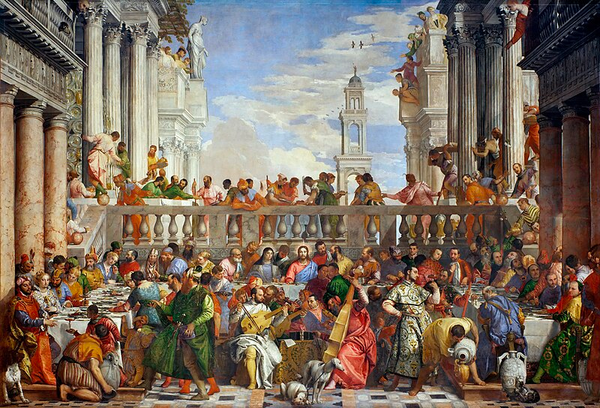
Wedding Feast at Cana by Paolo Veronese. 1563. Source.
Likely influenced by one of Renoir’s favorite Renaissance paintings at the Louvre — Veronese’s The Wedding Feast at Cana— Luncheon at the Boathouse lays out a banquet of splendor ripe with details. The composition is cleverly divided by the railing's diagonal line, separating the canvas into two halves: one densely populated with figures and the other almost empty, highlighting the figures of Louise-Alphonsine Fournaise and her brother, Alphonse Fournaise, Jr. This contrast enhances their prominence in the scene as the children of the popular restaurant's proprietor.
Renoir's alluring use of light is particularly notable in this composition. The main source of illumination filters through the balcony's canopy, effectively diffusing a soft light throughout the composition with the help of reflective elements like the singlets worn by two men in the foreground and the tablecloth.
Members of the Boating Party:
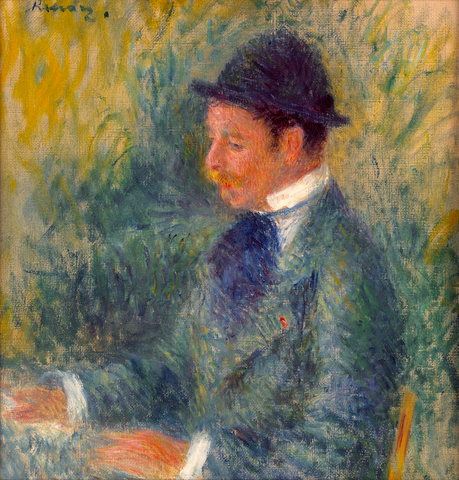
Renoir's frequent choice to paint his friends is understandable, as he could easily persuade them to pose for him. Given that many of the artist's friends were immersed in the leisurely lifestyle of high society, they naturally had ample leisure time available for such endeavors. Among these friends was Baron Raoul Barbier, a regular subject for the renowned Impressionist, who is also featured in a portrait from 1877.
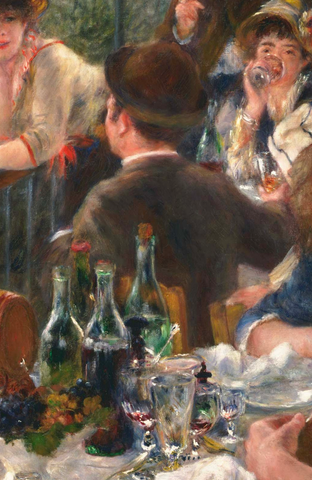
Close-up of Barbier.
If the figure in the bowler hat in this work seems familiar, it's likely because he also appears in Luncheon of the Boating Party, prominently featured at the center of the composition. Barbier appears with his back to the viewer as he speaks with Alphonsine Fournaise, the daughter of the establishment's owner. A man of considerable standing in both Renoir's intimate circle and Parisian society at large, Barbier was a former Cavalry officer, the Mayor of Saigon during French occupation and was well-known for his bohemian way of life. Only two other portraits of Barbier are known, and this portrait is pictured in multiple books, among them Guy Patrice and Michel Dauberville's catalogue raisonné of Renoir's work.
This thoughtful portrayal of a friend illustrates Renoir’s genius ability to employ his boundless artistry in rendering Parisian high society, almost in a dreamlike manner. Barbier seems caught in a moment of deep focus, absorbed in his reading. The subtle variations of color and ethereal quality of Renoir's brushwork imbue L'homme au petit chapeau with a sense of fluidity, as Barbier’s coat seems to melt into the background. The palette is rich in nuances of greenish blues, capturing the delicate interplay of natural light on the sitter's complexion and across Barbier's famous bowling cap.
Among the depicted figures are the painter and art patron Gustave Caillebotte, positioned in the lower right, and Renoir's future wife, Aline Charigot, who is seen in the foreground engaging with an affenpinscher dog. Charigot's inclusion in the painting came after Renoir replaced a previous model with whom he had grown dissatisfied.
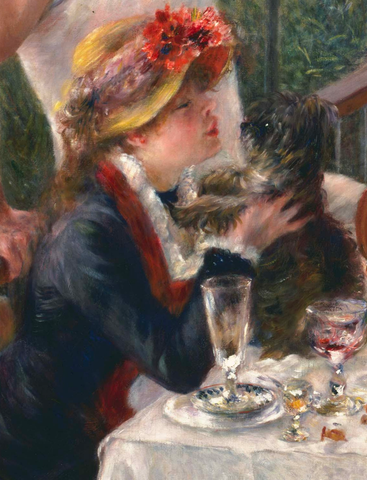
Close-up of Aline Charigot.
Other luncheon attendants include:
- Charles Ephrussi, a wealthy art historian and collector, is seen wearing a top hat in the background, possibly conversing with his secretary, the poet and critic Jules Laforgue.
- Actress Ellen Andrée is captured drinking from a glass at the center, with Baron Raoul Barbier seated across from her.
- Friends of Renoir, Eugène Pierre Lestringuez and Paul Lhote, appear in the upper right-hand corner, engaging with actress Jeanne Samary.
A Familiar Arrangement

Madame Paul Valéry by Pierre-Auguste Renoir. 1904. M.S. Rau.
Like many of the Impressionists, Renoir’s finest portraits feature his friends and family — they are suffused with familiar intimacy, an effect that is incredibly difficult to render with an unfamiliar subject. This intimacy closely aligned with Impressionistic ideals of capturing a fleeting moment on canvas. By painting his friends in casual, everyday settings, Renoir managed to invite his audience into his world, an effect that was dramatically different from the stark, serious portraiture of Academic work.
Additionally, during the early part of his career, Renoir, like many of his contemporaries, faced financial constraints. Painting friends and acquaintances could have been a practical choice, reducing the need for paid models. This practice was not uncommon among artists, especially those just beginning to establish their careers. This practice was also welcomed by many of the Impressionists. Renoir's friendships with other artists, such as Claude Monet, Alfred Sisley and Frédéric Bazille, provided a rich source of inspiration and mutual support.
Want to explore more of Renoir’s world? Check out our other portraits by the famous Impressionists, each with their own unique story to tell.
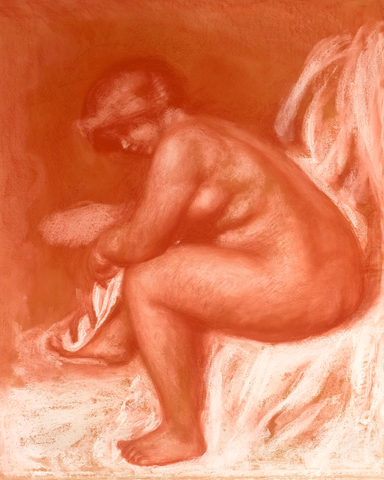
Après Le Bain By Pierre-Auguste Renoir. 1898. M.S. Rau.
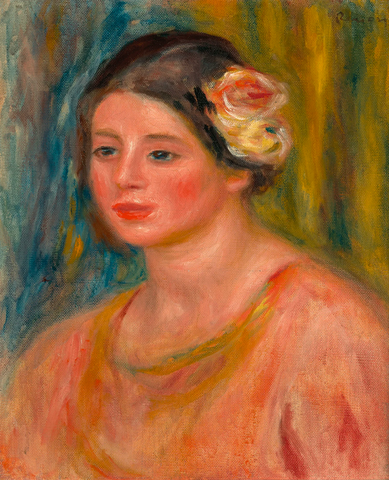
Madeleine By Pierre-Auguste Renoir. 1917. M.S. Rau.






